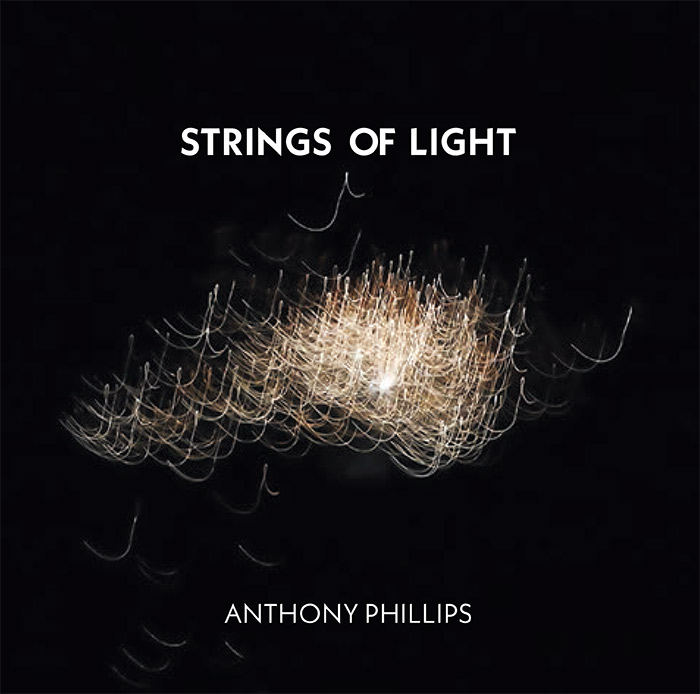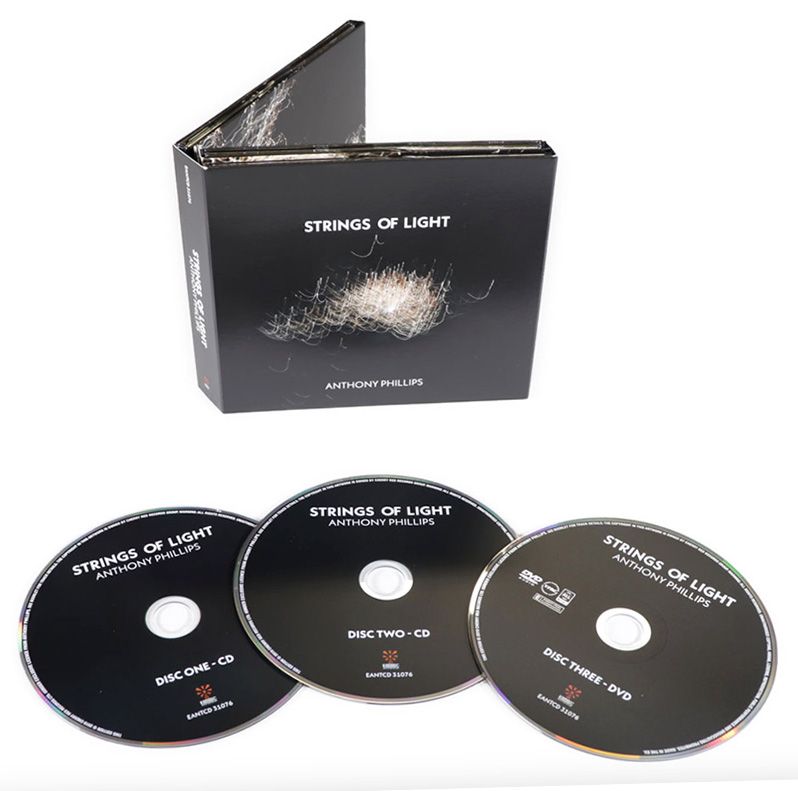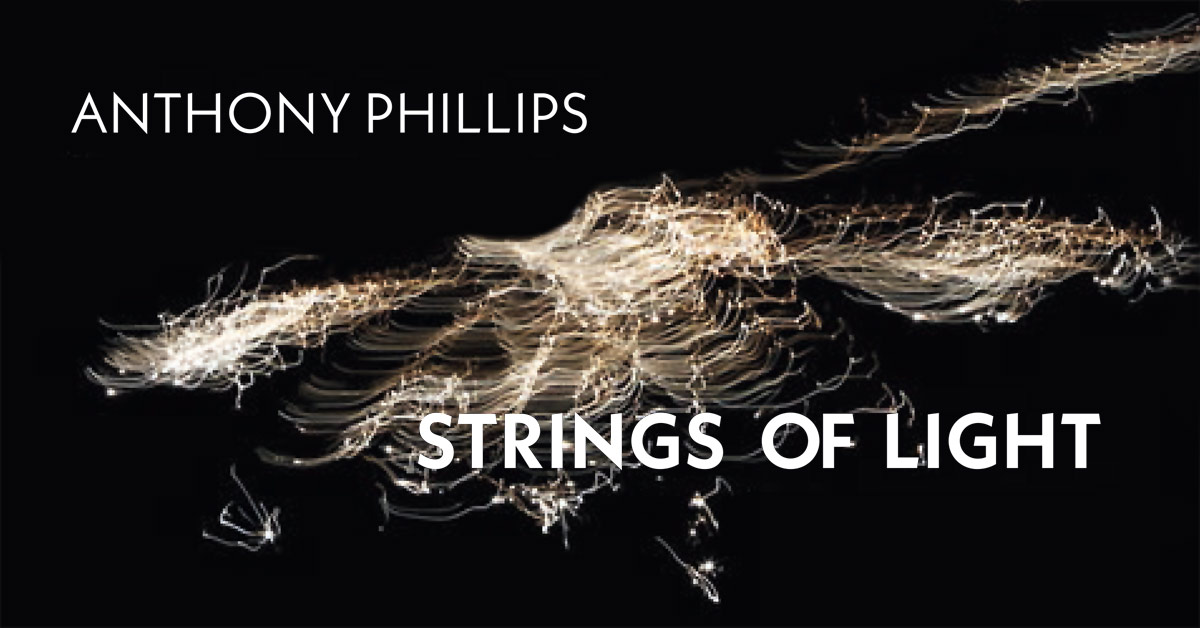- Article
- Read in 13 minutes
Anthony Phillips – Strings Of Light – 2CD/DVD review
Anthony Phillips has released his first solo album with new music in years. Andreas Lauer takes a closer look at Strings Of Light.
Seven long years have passed since Anthony Phillips released his last album of new music, City Of Dreams (Private Parts & Pieces XI). Since then Esoteric have re-released a bunch of older previously unreleased recordings (three Private Parts & Extra Pieces CDs, three bonus CDs for Slow Dance, Invisible Men and Seventh Heaven, ten bonus tracks on Harvest Of The Heart, Only Your Love) as well as some new material (two singles with Lettie Maclean, three tracks on Harmony For Elephants, Gemini and Il Crepusculo). A new full album, on the other hand, has always been described as desirable, but it was always stressed what an effort it was these days.
The announcement of a new album in August 2019 was therefore quite a surprise. Strings Of Light would contain guitar music only. Unlike Field Day, this project had been kept secret until the announcement. In his interviews with us (and other interviews accessible from his website) Ant has provided deep insights into how the album came about and into the way he works. We will not repeat all that here, though.
A look at Ant’s discography shows that Strings of Light is his fourth album to only contain guitar music. Each of these four albums has followed a different concept. Antiques (Private Parts & Pieces III) consisted of guitar duets that Ant performed and, for the most part, also wrote with Enrique “Quique” Berro Garcia. On the other three albums he played on his own. Twelve (Private Parts & Pieces V) used a single guitar, and it followed the idea of setting the twelve months of the year to music. Field Day was intended to present the various wonderful guitars Ant had collected; it took so long to come about that it eventually turned into a double album. String Of Light is an album Ant would not describe as a double album, as its playtime is only slightly longer than a standard CD. He calls it an “album with two sides” (as in the olden times of vinyl; and though vinyl is coming back, there will be no vinyl edition of this album). Ant employed the concept of two sides also on Dragonfly Dreams (Private Parts & Pieces IX), and, in a way, also on Gypsy Suite, though those were just on one CD. Field Dayand Strings Of Light both use a number of different guitars, but the approach on the one album is exactly the opposite of the other: On Field Day the idea was to showcase the instruments, and the compositions were chosen to fit the instrument. For Strings Of Light, Ant first had the music (ideas collected over some fifteen years) and then chose the instrument best suited to it.
Ant has expanded his collection of instruments since Field Day, and we get to hear some of the new instruments. Some of the 17 instruments (same amount as on Field Day) are long familiar, too, e.g. the characteristic Bell Cittern we know from Bel Ami.

The album has 24 pieces, twelve to each “side”. That brings up ideas and makes you think of, perhaps, collections like Johann Sebastian Bach’s Well-Tempered Clavier and others, where one piece was written for each of the 12 major and 12 minor keys – but that does not apply here. Neither is the release in the upcoming Christmas season to be understood as a kind of advent calendar. The number of 24 pieces is more or less random. In fact, there was considerable doubt whether four particularly tricky pieces would come about. Even when those four had finally been recorded successfully in April 2019 there was some indecision as to whether two pieces should be left off the album to fit all the music on one CD. In the end they decided to split the album into a listening experience of “two sides” with time for a nice tea break in between. The average piece is 3:35 long (on Field Day, 2:07) and varies from 21 seconds to ten minutes (on Field day, 27 seconds to 8:27).
As we pop in the CD one question looms large for the Phillips fan: Has he still got it? Is he still up to creating original music, creating something new? Let’s press play and listen …
I/1 Jour de Fête
It is meant to be a day of celebration, and this sets the positive mood the „strings of light“ are to exude (despite all the variety of atmosphere we will experience on the way). Like The Geese & The Ghost, New England, Field Day, and City Of Dreams, the album begins intentionally with a simple piece; cheerful, few contrasts, the tonic D almost always present. You can hear the Bell Cittern here … and you can also see it, for there is an official live performance video of the piece.
I/2 Diamond Meadows
What a contrast to the opening piece! A twelve-string guitar blazes out, sparkles (like diamonds) in its splendor. In an interview, Ant explained the effect with the choice of strings (silk and steel), but added that most of the effect came by tuning the six pairs of strings to different notes (usually both strings of a pair are tuned to the same note, occasionally transposed by an octave). This has given him much richer chords. It is quite worthwhile comparing the version from Ant’s live video where – to keep up the metaphor – the diamond sparkles in a slightly different light.
The piece is a kind of toccata in C in the pattern of AABCCD, with an eight-bar A and a four-bar C. B is a bit slower and played rubato, whereas D is groovy with some shifts in the musical stress, changing between major and minor keys (blue notes, as it were). It ends in a long, calm coda with string harmonics.
I/3 Caprice In Three
The next two pieces are played on a classical (six-string) guitar by David Whiteman. It is the instrument most frequently used on the album as you can also hear it in Pilgrimage Of Grace and Fleur-de-Lys. It is a not at all capricious, songlike G major piece in 3/4. Its structure is AABABA plus coda, with the harmonics of the B part moving as far as B flat major. Caprice In Three has something of the spirit of Lullaby – Old Father Time. That song used a second guitar, though, and did not have the contrasting second part.
I/4 Castle Ruins
Ant found it difficult to find a title for this piece. He had an idea of something Iberian, something medieval … The motive sounds a bit like a tolling bell (perhaps the former bell of the ruined castle) and reminds me of Church Bells At Sunset.
There are a number of noteworthy things in this apparently simple piece: Time changes that go by almost unnoticed because of a fermata or a pause, and the extraordinary Phrygian-dominant scale on G that is resolved to C major at the end.
I/5 Mermaids and Wine Maidens
This song is related musically to Diamond Meadows. It is a toccata in D played on a six-string guitar. It is a bit richer in melodics in the descant. The end reprises the beginning.
I/6 Winter Lights
Winter Lights is not only the longest piece on “Side 1”, but also one of the four pieces that Ant found particularly difficult to record. It is one of two very old pieces that go back to 1971; Ant discusses it a length in our interview. Actually, only the opening part (and its later reprise) is old; the part from 1:57 to 3:51 is probably what was newly written. You wouldn’t know there are fifty years between the writing of both bits, though. Winter Lights is most likely the piece Ant mentions in the interview as having five or six twelve-string guitar mixed on top of each other. The initial theme is striking, and the whole piece (written in D) resembles material from the 1970s, e.g. Tregenna Afternoons, Gypsy Suite.
I/7 Song for Andy
There are no indications to which Andy exactly this very tasteful song without words is dedicated. The melody is sketched out in the descant, the piece has several verses and a bridge. The tonic G does not appear anywhere in the lower voice except for the closing cadences. This keeps the piece in the air and keyed up for the release. It would be great to hear the Song For Andy one day with lyrics on a song album of Ant’s!
I/8 Pilgrimage of Grace
Change from G major to E minor. Structure: AABABA’, similar to Caprice In Three. The upper voice has the lightest sketch of a melody with charming legato elements (i.e. the left hand slides along the string to the new note). E minor contrasts with the opposing C major, then with a diminished C sharp chord and finally, rather crass and savouring it, with C minor.
The title refers to a historical event, an uprising against Henry VIII.
I/9 Skies Crying
What a track! Lively changes between tension and relief in high position with lots of reverbertion (resembling White Spider), then a strumming part, all this in C Sharp minor. For the first time on the album the rain is evoked that Ant wanted to feature in the originally intended album title, Rainy Day Postcard.
I/10 Mouse Trip
Though it is only 1:05 long, this is probably the one piece on the album that was the most difficult to play. It uses a playing technique that Ant calls dubbing (which may be identical with palm muting) and has impressively fast plectrum triplets on classical guitar. Mouse Trip is quite a simple composition, but it may be the children’s favourite on the album as well as the scherzo that hardly any of Phillips’s album omits. Special effects added by sound engineer James Collins contribute to the quirky character of this piece in G major; the “wrong” notes, whether added into the mix or collateral sound of the performance, fit the style very well. It may not be the most sophisticated listening pleasure on the album, but it breaks new ground. The humorous note is underlined by the playful title that puns on mouse trap.
I/11 Restless Heart
One of the richest compositions on the album, Restless Heart wanders restlessly between various keys (F major at times, E minor at others) and various time signatures – sometimes in 10, in 5 or in 4, and rubato and short breaks leave the listener uncertain about the time in which this restless heart is beating. One of the highlights of the album.
I/12 Still Rain
The rain returns with lots of reverb as in Skies Crying, but softer and gentler this time. The strings are plucked in two patterns. The initial pattern A returns at 2:07, while pattern B begins at 1:03 and 2:45. The keys change from E minor to B minor, finally to G major. The A minor chord in the B minor part at 3:20 is simply breathtaking. Uplifted this way we let the rain fade away and turn to a nice cuppa tea.

If you think that CD2, or “Side 2” contained lesser material you are in for a pleasant surprise.
II/1 Into the Void
You cannot tell just from listening how these 21 seconds of sound are created. Ant explains it at length in our interview. Does the shortening of time intervals really follow an exponential function, as Ant suspects? We have not calculated it, but experiments on the intervals at which a ball jumps up and down seem to support that theory. Unless the ear is deceived by overtones, the twelves strings appear to be tuned in EBcdeg (at least this is what I hear).
II/2 Andean Explorer
The album continues with the same guitar and certainly a different tuning. The first 80 seconds embody the love of adventure. Its dramatic liveliness reminds me of Twelve or Flamingo. The piece is as changeable as Restless Heart, but with more positive connotations. A slower part probably illustrates the Andean explorer coping with the challenges of the high plateau; it is full of lush peculiar chords rich in subtle dissonances and grace notes. A brief, questioning part beginning at 2:37 leads into a reprise of the beginning and a piece that has captured the listener from the beginning ends with a 7-9-11 E minor chord.
II/3 Mystery Tale
This is where the “toy guitar” Guitarina comes in. A drone in E and B lays the foundation for a brief, simple melody in a harmomic minor scale with gentle legato moments.
II/4 Sunset Riverbank
This is -the- resting point of the album. A six-string guitar plays its part three times. During the third time (which begins at 1:55) it does not switch to D major anymore. Instead, a tender solo played on the electric guitar (a Fender Stratocaster) is added on top. This piece is made to listen to on repeat so you can calm down and drift away.
II/5 Tale Ender
If Mystery Talewas not mysterious enough for you, well, it has not ended yet. It is reprised here, mainly in the reverb, like a dream vision of Mystery Tale that finally lives up to its name. Tale Ender is the last of three sound experiments (with Mouse Trip and Into The Void) that loosen up the album in the middle.

II/6 Shoreline
We have reached track number 6 again. Again we hear the 12-string L’Arrivée, and again it’s an old piece (this time completely old). Shoreline is the simplified third movement of a quintette in four movements simplified for one guitar. Ant wrote the quintette in 1971 for guitars and for strings and brass instruments, respectively, but never completed or recorded it. The first movement could be heard as Conversation Piece on Radio Clydeand at the Living Room Concert. Musically, it slightly resembles the Tibetan Yak Music. A motive like the breaking of waves appears in various shapes, in a slow 3/4 from 1:07 onwards. It is contrasted with a fine melody from 1:43 onwards. At 2:38 the piece suddenly begins to start over. It is remarkable for its calm strength and the colourful changes of timbre.
II/7 Days Gone By
A meditation in G in 7/8, rather unlike a song, with a very simple melody. With a structure of AABA’ABA’A” it is slightly too long at 3:44.
II/8 Crystalline
This very disciplined fantasia on a twelve-string guitar may have its name for similar reasons as Diamond Meadows, so it represents the essence of the album title.
II/9 Fleur-de-Lys
A slow four-part composition, dissolved in triplets. This could also be a movement in the style of a baroque air for a string quartet – hence probably the name: the fleur de lys, the lily is part of the coat of arms of the French kings.
II/10 Grand Tour
This piece may have its title from its six-minute length or from the 16 strings the guitar has. The use of this instrument made it a particular challenge for Ant. It starts off with interesting chords based on A, and the deep A’ we hear is really impressive. At 2:08 a calmer part in E begins, the first part is reprised at 3:45, and groovy strumming comes in at 4:16. The piece ends, surprisingly, in B major. In some places the instrument Michael Cameron made especially for Ant sounds like an accordion.
II/11 Home Road
Time to breathe before the grand finale of the album. Jour De Fête and Home Roadare the brackets around (almost) the whole album. It used the Bell Cittern again, and it is very cheerful, simple and short.
II/12 Life Story
The last and longest „beast“ Ant had to deal with both as a composer and a player, is this ten-minute piece in D. In our interview with him Ant goes into the nuts and bolts of this piece. Life Story is particularly attractive because of the warm sound of the almost 90 year old Spanish instruments, the lavish ornamentations, some harmonic turns (the C7-9 in the beginning, the cadence at 7:20, the B flat 7 chord at 8:14) and the pianissimo ending with its tricky simultaneous combination of shimmering and hammer-on. Whether it conjures up images of the sea (Ant’s original vision of the song) or a Life Story, the ending fits the concept of expiring life.
Back in the present we look back on an album of versatile music that is evidently an album of Ant’s but still has turned many new ideas into music. The big new thing is: the unique sound that, as Ant puts it, lets the recording sound more like the actual instrument than ever before. The effects, mainly reverby and cross-fading, are employed only to support the song-writing and never trespass into tampering with it (except for the three experimental pieces above, perhaps). Anthony Phillips has used the kairos, the good opportunity to use the instrument that most permits him to be original to create and record music. For this, our thanks, Ant!
What else is there to say? You get a surround sound DVD with the album. Its effect is limited, of course, on an album where, for most of the time, you only hear one instrument. – It appears for the cover artwork light points shaped like a guitar were photographed in motion, much like the cover for And Then There Were Three. The cover art inspired the album title. – The liner notes are brief. At their ending Ant thanks three women in a remarkable way.
By Andreas Lauer (10/2019), English by Martin Klinkhardt
Strings Of Light was released by Esoteric/CherryRed as 2CD/DVD digipak can be ordered directly at CherryRed.

